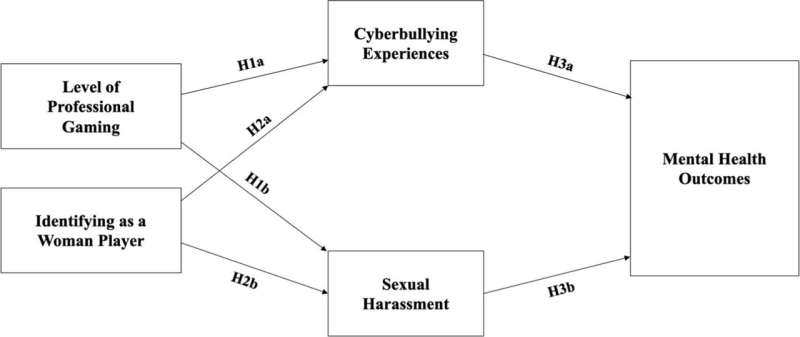This article has been reviewed according to Science X's editorial process and policies. Editors have highlighted the following attributes while ensuring the content's credibility:
fact-checked
trusted source
proofread
Cyberbullying and sexual harassment rampant in esports, study finds

It's one of the fastest growing industries globally, raking in millions for the best players and attracting a huge fanbase, but a new Australian study has revealed the dark side of professional video gaming: cyberbullying and sexual harassment.
Even though the esports industry is a diverse community, cyberbullying is rampant in this virtual world, and cis-gendered and trans-gendered women players are disproportionately more likely to be sexually harassed than men.
Despite women making up 46% of the world's three billion video gamer players, according to a paper published in Entertainment Computing, women who play professionally (16% of esports competitors and content creators) are the most vulnerable to cyberbullying and sexual harassment. The paper is titled "Pro Gamers and Cyberbullying: Workplace Bullying and Sexual Harassment in Professional Video Gaming."
University of South Australia (UniSA) psychology Ph.D. candidate Louise Trudgett-Klose and Dr. Sarven McLinton authored the paper, surveying 145 videogame players from 14 countries, 96% of whom said they had been cyberbullied in the previous 12 months.
Almost half of the bullying (49%) came from co-workers (other players) and the other half from the public.
"There was a definite link between the level of professional gaming and the incidence of cyber bullying, and sexual harassment for women players," says Trudgett-Klose. "The more professional a player becomes, the more they are exposed to hostile behavior, which affects their mental health."
Cyberbullying involves name calling, derogatory comments, excluding specific players and restricting access, verbal threats and manipulative tactics, whereas sexual harassment includes being sent explicit messages and images and unwanted sexual comments.
"It's not just an isolated incident. The fact that 96% of players—professional or otherwise—experienced cyberbullying in the previous 12 months suggests that toxic behaviors are prevalent in the gaming community."
Gaming professionals who attracted the most fame—characterized by having a large fan base and presence on platforms like Twitch and YouTube—were exposed to the worst levels of cyberbullying.
"It is important to note that playing video games itself is not the issue," Dr. McLinton says. "However, the culture around gaming is hyper masculine and very much targeted towards heterosexual men. Anyone who falls outside that group is more vulnerable."
Most professional players are independent and not protected by an organization, leaving them without a governing body to enforce safety and protection.
"New avenues need to be explored to better support emerging professionals in this contemporary era of gaming work, protect their mental health, and create a safer virtual environment for everyone," Dr. McLinton says.
The UniSA researchers are part of a new research group called HIGHER (Healthy Inclusive Gaming, Hobby & Esports Research) that aims to better understand players, performance, culture and workers in the burgeoning esports industry.
Their research includes all aspects of esports competition; mental health and well-being of players; the inclusion of esports in schools and the community; cyberbullying and online safety; gender and sexuality in gaming; the role of gaming in work/life balance; and how emerging technology such as AI impacts the esports industry.
More information: Louise H. Trudgett-Klose et al, Pro Gamers" & Cyberbullying: Workplace bullying & sexual harassment in professional video gaming, Entertainment Computing (2024). DOI: 10.1016/j.entcom.2024.100702
Provided by University of South Australia




















